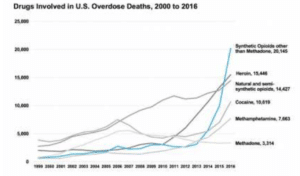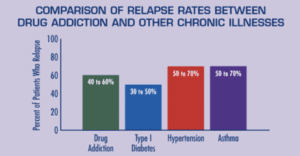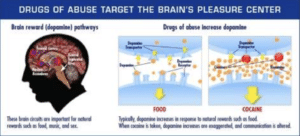The journey to recovery is full of mountains and valleys, victories and defeats, wins and losses, life and death.
The nature of addiction for relapse prevention is a process that involves:
- The loss of control over alcohol or using drugs
- Obsessive thinking about using drugs or alcohol
- Not considering the ongoing negative consequences of additions to alcohol and drugs
- Relapse by returning to drinking after trying to stop drinking.
According to the National Institute on Alcohol Abuse and Alcoholism, research has shown that roughly 90% of people with alcoholism relapse within 4-years of completing treatment. Addiction for relapse prevention is the fundamental challenge for individuals with Substance Use Disorder.
Relapse prevention is critical because the alternative can lead to overdose deaths.
Below is a chart which shows some statistics relative to U.S. Overdose Deaths, 2000 to 2016.

However, it is important to understand the chronic nature of the disease which makes relapse more likely. The characteristics of chronic diseases, such as; diabetes, hypertension, and asthma have similar relapse relative to treatment involving both physiological and behavioral components.
Therefore, treatment of any chronic disease involves changing deeply imbedded behaviors. A recovering drug addict who relapses indicates that treatment needs to be reinstated or adjusted or that another treatment should be tried.
Getting over an addiction for relapse prevention is a process, not an event and to understand relapse prevention it is important to understand the stages of relapse:
- Emotional relapse
- Mental relapses
- Physical relapses
In the chart below you can see the comparison of relapse rates between drug addiction and other chronic illnesses which involve both physiological and behavioral responses.

All recovering people have a lifestyle that includes people, places, emotions and things that in the past have been associated with using alcohol or drugs. Consider the high-risk people, places, things, and feelings which are referred to as “triggers.”
A trigger is something that will lead to thoughts about substance use. These thoughts of using drugs lead to a craving, and the craving can lead to a relapse. Because research has shown that alcohol or other drugs cause chemical changes in the brain, these changes make a person vulnerable to relapse.
Therefore, the physical changes in the brain of an individual in recovery will be more likely to relapse. The chart below shows the brain reward (dopamine) pathways and how the brain circuits are important for natural rewards, i.e., food, music, and sex. Taking drugs of abuse target the brain’s pleasure center.
There are both internal triggers and external triggers to be taken into consideration.
- An internal trigger is an emotional state that you might experience before, during, or after substance use. You may have felt very happy, depressed, anxious, or sexually aroused while you were using. Later, these feelings can remind you of substance use.
- An external trigger includes events, places, things, or specific times that you associate with substance use. An external trigger might include hanging out with friends in your apartment complex where in the past you drank alcohol or used drugs. There may be a dealer who lives in a house just down the street from your home. When you take a walk in your neighborhood you might see people walking in and out of the drug dealers home or you may even see drug paraphernalia on the ground, i.e., needles, empty baggies, broken liquor bottles. It is critical to be aware of the sensory triggers, i.e., senses of sight, sound, smell, taste, and touch. These are sensations that remind you of drug use. Just like the sensory triggers for someone with PTSD these triggers can transport a person to the scene of a party where everyone was having a good time or the scene of a war zone. For example, seeing white powder on a mirror, listening to a specific type of music, smells, and tastes all trigger thoughts of drug use.
The first line of action to prevent relapse is to avoid the external triggers caused by people, places, and things. The internal triggers may require additional psychotherapy or pharmacotherapy to help with depression, anxiety, substance abuse mood disorders, or the inability to find joy.
In many cases, this will require some dramatic changes in your life to change your environment. These necessary changes may require you to find another place to live. It may require you to change employment and not associate with friends who are still choosing to use drugs and alcohol.
Practice self-care which can help to prevent relapse when inner triggers arise. In the past, you may have used drugs and alcohol to create situations that promote a way to escape the mental and emotional stressors. Someone who has developed an addiction to a substance will many times neglect their self-care routines.
Although there are many approaches you can use to help prevent a relapse, I would like to share a story shared with me by a little boy age four who we will call Jimmy. The story is about his search for a treasure chest and the three keys he will need to open it when he finds it. He has a treasure map, but it only shows him where the treasure is and without the three keys he will not be able to open it. Metaphorically we can use this story to find the three keys and open the treasure chest.
The three keys will represent the treatment for each of the three phases of relapse:
- Emotional relapse
- Mental relapses
- Physical relapses
According to Jimmy, the first key is green. The green key may be in possession of someone you know or may be hidden in plain sight. To find this key, it may require you to address emotional hurt from a previous relationship. This step may require you to find forgiveness in your heart for the person who hurt you and for yourself. The green key helps to prevent an emotional relapse. The first key represents “trust,” and when combined with forgiveness it can help heal emotional wounds.
The second key is red. The red key may be found in the “basement of your mind” where it has been covered with dust. The red key will require you to use thought stopping techniques to clear the dust and direct your thoughts away from wanting to use. It may require you to try a hobby like painting or going hiking with a friend. Helping others, i.e., volunteer work to help others can also deter a mental relapse. The second key represents “hope,” and when combined with discipline and helping others, it can help heal mental wounds.
The third key is blue. The blue key represents “gratitude.” When we have gratitude, we don’t search for drugs to mask pain, to take away boredom, to escape reality, or just get “high.” With gratitude, you become mindful of every breath you take which offers the gift of life, and you express thankfulness for every second of every day. When you are in a mindful state, you remember your self-care routine which can help prevent a physical relapse.
“When you learn to ‘love yourself’ it becomes a perpetual relapse prevention intervention.”
Once you have all three keys, use the map that was given to you before birth that has always been inside your heart. The treasure chest is “you,” and when the treasure chest is opened, you will see a golden light that is all-encompassing. The light will open your heart to unconditional love. You have found the light of the “Divine Source of Love,” and it will fill up your “whole body” with pure love. You will gain the ability to love yourself and others. Compassion and love offer a new beginning where the past is gone forever, the present is mindful and synchronistic, and the future will offer great joy. When you learn to “love yourself” it becomes a perpetual relapse prevention intervention.
Get help. Learn more about Addiction for Relapse Prevention by reading this article, “Relapse Prevention During Recovery”


